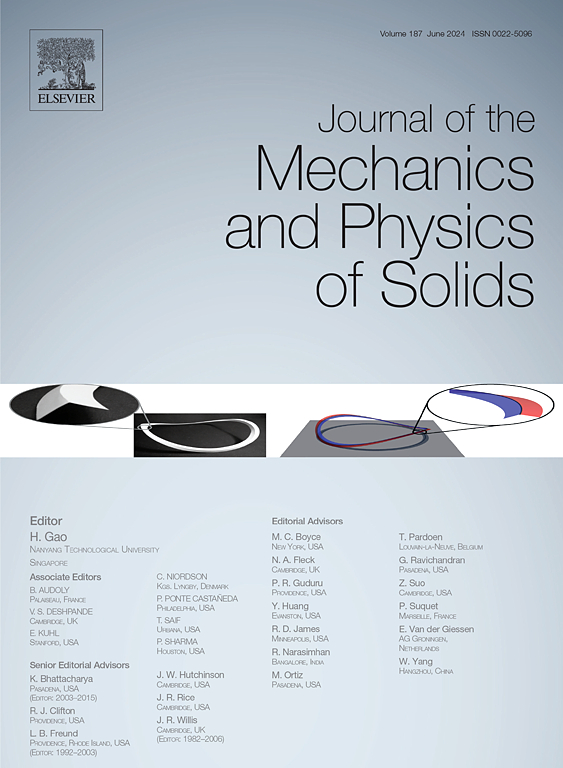泰勒-昆尼系数由拉伸试验中均匀变形和局部变形的同时应变和温度测量确定
IF 5
2区 工程技术
Q2 MATERIALS SCIENCE, MULTIDISCIPLINARY
引用次数: 0
摘要
本文介绍了在1.0 s-1和500 s-1的名义应变速率下的拉伸试验中Taylor-Quinney系数(TQC) β的实验测定。在整个测试过程中,试样表面的变形(应变)和温度同时进行全场测量,包括在缩颈期间的局部区域。这些测量提供了确定大应变下TQC值的方法。测试Inconel 718的结果表明,在测试的均匀变形部分(在颈缩开始前达到约0.15的应变),试样的计截面中心的条件在两种应变率下都是绝热的,TQC可以准确地确定。一旦它发展,在颈部区域观察到大的应变和显著的温度升高。对实测数据的分析表明,在500 s-1应变速率下,缩颈过程足够快(约165 μs),使得缩颈中心在绝热条件下发生变形,在0.36应变范围内可以准确测定TQC。在1.0 s-1应变率试验中,缩颈过程持续时间较长(约110 ms),部分热量从缩颈区域中心传导,只有在0.15应变下均匀变形时才能准确测定TQC。本文章由计算机程序翻译,如有差异,请以英文原文为准。

Taylor-Quinney coefficient determination from simultaneous strain and temperature measurements of uniform and localized deformation in tensile tests
Experimental determination of the Taylor-Quinney coefficient (TQC), , from tensile tests at nominal strain rates of 1.0 s-1 and 500 s-1 is presented. Simultaneous full-field measurements of the deformation (strain) and temperature on the surface of the specimens are made throughout the tests, including in the localized region during necking. These measurements provide means to determine the value of the TQC at large strains. Results from testing Inconel 718 show that during the uniform deformation portion of the tests (up to a strain of about 0.15 before necking initiation) the conditions at the center of the specimen's gage section are adiabatic in both strain rates and the TQC can be determined accurately. Large strains and significant increase in temperature are observed in the necking region once it develops. Analysis of the measured data shows that in the 500 s-1 strain rate test the necking process is sufficiently fast (about 165 μs) such that the center of the necking deforms under adiabatic conditions and the TQC can accurately be determined up to a strain of 0.36. In the 1.0 s-1 strain rate test, where the necking process lasts much longer (about 110 ms), some heat is conducted away from the center of the necking region and the TQC can accurately be determined only during the uniform deformation up to a strain of 0.15.
求助全文
通过发布文献求助,成功后即可免费获取论文全文。
去求助
来源期刊
CiteScore
9.80
自引率
9.40%
发文量
276
审稿时长
52 days
期刊介绍:
The aim of Journal of The Mechanics and Physics of Solids is to publish research of the highest quality and of lasting significance on the mechanics of solids. The scope is broad, from fundamental concepts in mechanics to the analysis of novel phenomena and applications. Solids are interpreted broadly to include both hard and soft materials as well as natural and synthetic structures. The approach can be theoretical, experimental or computational.This research activity sits within engineering science and the allied areas of applied mathematics, materials science, bio-mechanics, applied physics, and geophysics.
The Journal was founded in 1952 by Rodney Hill, who was its Editor-in-Chief until 1968. The topics of interest to the Journal evolve with developments in the subject but its basic ethos remains the same: to publish research of the highest quality relating to the mechanics of solids. Thus, emphasis is placed on the development of fundamental concepts of mechanics and novel applications of these concepts based on theoretical, experimental or computational approaches, drawing upon the various branches of engineering science and the allied areas within applied mathematics, materials science, structural engineering, applied physics, and geophysics.
The main purpose of the Journal is to foster scientific understanding of the processes of deformation and mechanical failure of all solid materials, both technological and natural, and the connections between these processes and their underlying physical mechanisms. In this sense, the content of the Journal should reflect the current state of the discipline in analysis, experimental observation, and numerical simulation. In the interest of achieving this goal, authors are encouraged to consider the significance of their contributions for the field of mechanics and the implications of their results, in addition to describing the details of their work.

 求助内容:
求助内容: 应助结果提醒方式:
应助结果提醒方式:


